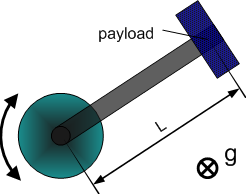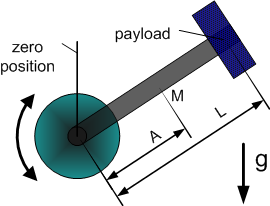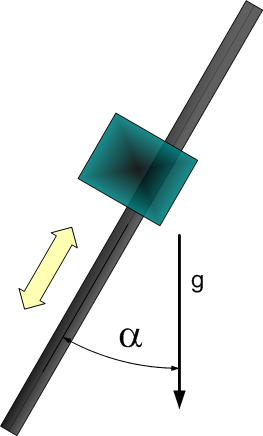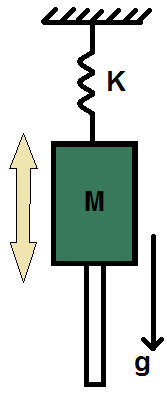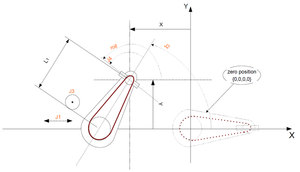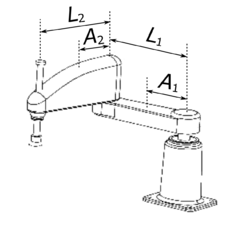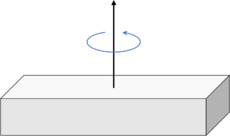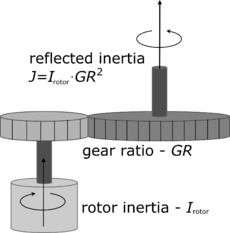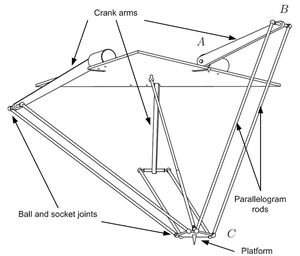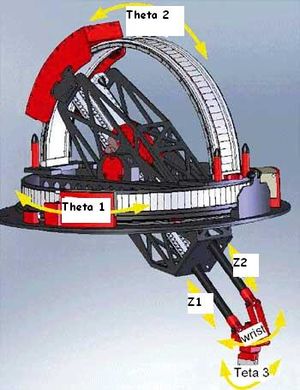Difference between revisions of "Dynamic Models"
| Line 312: | Line 312: | ||
| | ||
| + | |||
| Line 341: | Line 342: | ||
| 13 | | 13 | ||
| <math>I_3+I_0+M_0 L_{0x}^2</math> | | <math>I_3+I_0+M_0 L_{0x}^2</math> | ||
| − | | kg*m<sup>2</sup>, includes the additional term <math>M_0 L_{0x}^2</math> | + | | kg*m<sup>2</sup>, includes the additional term <math>M_0 L_{0x}^2</math> in accordance with the parallel axis theorem |
|} | |} | ||
Revision as of 14:45, 2 June 2020
This page gives an overview over all implemented dynamic models.
General considerations
- Friction is handled on axis basis. The parameters for friction are set for each axis separately.
- Torque (Force) is always expressed in [Nm] ([N])
Contents
Rotational Axes
Dynamic Model 1 - simple rotary axis
| Number | Parameter | Comments |
|---|---|---|
| 1 | Total moment of inertia around the rotation axis of the moved part |
- Model equation
Dynamic Model 2 - horizontal crank-arm axis
| Number | Parameter | Comments |
|---|---|---|
| 1 | Total moment of inertia around the rotation axis of the moved part | |
| 2 | Square of length of crank arm (axis to payload) |
- Model equation
Dynamic Model 3 - vertical crank-arm axis
| Number | Parameter | Comments |
|---|---|---|
| 1 | Total moment of inertia around the rotation axis of the moved part | |
| 2 | Square of length of crank arm (axis to payload) | |
| 3 | Mass (without payload) * Gravity * Distance to center of mass | |
| 4 | Gravity * Distance to Payload |
- Model equation
Linear Axes
Dynamic Model 1 - horizontal axis
| Number | Parameter | Comments |
|---|---|---|
| 1 | Total mass of the moved part. |
- Model equation
Dynamic Model 2 - vertical or tilted axis
| Number | Parameter | Comments |
|---|---|---|
| 1 | Total mass of the moved part. | |
| 2 | Constant force due to gravity. | |
| 3 | Gravity coefficient used to consider payload mass. (g = 9.80665) |
- Model equation
Dynamic Model 3 - vertical axis with a spring
| Number | Parameter | Comments |
|---|---|---|
| 1 | Total mass of the moved part. [kg] | |
| 2 | The stiffness constant of the spring. [kg/s^2] | |
| 3 | The stiffness constant times the relaxation position of the spring. [kg*m/s^2] |
- Model equation
Traverse Arm Robots
Dynamic Model 1
| Number | Parameter | Comments |
|---|---|---|
| 1 | ||
| 2 | ||
| 3 | ||
| 4 | ||
| 5 | ||
| 6 | ||
| 7 |
Scara Robots
The dynamic equations of the robot are expressed at the outputs of the gearboxes attached to the actuation motors. Therefore, the torques, joint positions, velocities, and accelerations are those of the gearbox output shafts.
In the following models, the variable for is the mass of link . Link is a ball screw. The variable is the lead of the ball screw, i.e. the linear distance traveled for each complete turn of the screw. The internal units of are [mm/deg], while its user units are [m/rad].
The variables and are the lengths of links and . The variables and are respectively the distances of the exes of joints and to the centers of mass of links and .
The variable for is the moment of inertia of link , relative to a reference frame attached to the link's center of mass, and about the link's axis of rotation.
Additionally, for is the moment of inertia of rotor , reflected to the gearbox output shaft as follows. Let be the moment of inertia of rotor relative to a reference frame attached to the rotor's center of mass, about the rotor's axis of rotation. Let be the gear ratio of the gearbox or pulley system, then .
The variables and are respectively the payload mass and payload moment of inertia relative to its center of mass. If no object or gripper is attached to the robot, the value of these variables is zero.
Dynamic Model 1
For non-coupled SCARA robots (axis 3 and 4 are not coupled) and for concentric payloads (concentric with axis 4).
| Number | Parameter | Comments |
|---|---|---|
| 1 | kg*m2 | |
| 2 | kg*m2 | |
| 3 | kg*m2 | |
| 4 | kg*m2 | |
| 5 | kg | |
| 6 | kg*m/sec2 | |
| 7 | kg*m2 | |
| 8 | kg*m2 |
Dynamic Model 2
For coupled SCARA robots (axis 3 and 4 are coupled) and for concentric payloads (concentric with axis 4).
| Number | Parameter | Comments |
|---|---|---|
| 9 | kg*m2 | |
| 10 | kg*m2 | |
| 11 | kg*m2 | |
| 12 | kg | |
| 13 | kg*m2 | |
| 14 | kg*m2 | |
| 15 | kg | |
| 16 | kg*m2 |
The payload parameters for Dynamic Model 1 and Dynamic Model 2 are:
| Number | Parameter | Comments |
|---|---|---|
| 1 | payloadMass | , the mass of the payload |
| 2 | payloadInertia | , the payload's moment of inertia relative to its center of mass |
Dynamic Model 3
For coupled SCARA robots (axis 3 and 4 are coupled) and for non-concentric payloads (non-concentric with axis 4).
The dynamic parameters are the same as model 2, except for parameter No. 13.
The payload parameters are:
| Number | Parameter | Comments |
|---|---|---|
| 1 | payloadMass | , the mass of the payload |
| 2 | payloadInertia | , the payload's moment of inertia relative to its center of mass |
| 3 | payloadLx | , the distance to the center of mass from the 4th axis in the x direction |
| 13 | kg*m2, includes the additional term in accordance with the parallel axis theorem |
When using identification with this model, all of the payload parameters can be found.
Dynamic Model 4
Same as Dynamic Model 3.
This model is used in identification process in order to identify the payloadMass parameter only, by moving only joint number 3.
Dynamic Model 5
Same as Dynamic Model 3.
This model is used in identification process in order to identify the payloadInertia and payloadLx parameters, by moving only joint number 4 and very small movements in joints 1 and 2.
Delta Robots
Dynamic Model 1
| Number | Parameter | Comments |
|---|---|---|
| 1 | kg*m2 | |
| 2 | kg*m2/sec2 | |
| 3 | kg | |
| 4 | kg*m2 | |
| 5 | kg | |
| 6 | kg | |
| 7 | kg*m2 | |
| 8 | kg*m2 | |
| 9 | m | |
| 10 | m | |
| 11 | ||
| 12 | ||
| 13 | ||
| 14 |
Puma Robots
Dynamic Model 1
Description:
- - Gravity constant
- - Mass of the ith link
- - length of the common normal between the ith and ith+1 joints
- - offset along z axis between the ith and ith+1 joints
- - The distance from the ith joint to the center of mass of the ith link
| Number | Parameter | Comments |
|---|---|---|
| 1 | |
kg*m^2 |
| 2 | kg*m^2 | |
| 3 | kg*m^2 | |
| 4 | kg*m^2 | |
| 5 | kg*m^2 | |
| 6 | kg*m^2 | |
| 7 | kg*m^2 | |
| 8 | kg*m^2 | |
| 9 | kg*m^2 | |
| 10 | kg*m^2 | |
| 11 | kg*m^2 | |
| 12 | kg*m^2 | |
| 13 | kg*m^2 | |
| 14 | kg*m^2 | |
| 15 | kg*m^2 | |
| 16 | kg*m^2 | |
| 17 | kg*m^2 | |
| 18 | kg*m^2 | |
| 19 | kg*m^2 | |
| 20 | kg*m^2 | |
| 21 | kg*m^2 | |
| 22 | kg*m^2 | |
| 23 | kg*m^2 |
Dynamic Model 2 - Gravity
This dynamic model is for cases where the robot moves very slowly.
In such cases, the accelerations and velocities of the joints of the robot have little effect on the joints torques. The joints torques are mainly affected by gravity and friction.
This model includes only the gravity and friction part of the PUMA robot dynamic model.
| Number | Parameter | Comments |
|---|---|---|
| 1 | kg*m^2/s^2 | |
| 2 | kg*m^2/s^2 | |
| 3 | kg*m^2/s^2 | |
| 4 | kg*m^2/s^2 |
Galileo Spherical Robots (GSR)
Dynamic Model 1
| Number | Parameter | Comments |
|---|---|---|
| 1 | mP | Payload mass [kg] |
| 2 | mB | Balance mass [kg] |
| 3 | TP | Payload mass center distance from the flange [mm] |
| 4 | TB | Balance mass center distance from the (0,0) [mm] |
| 5 | IR | Inertia of the payload around roll [kg*m2 |


